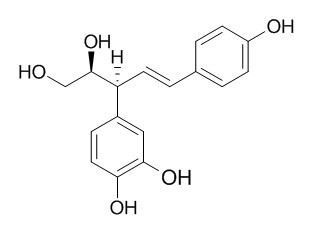Sequirin C
Sequirin C can inhibit feeding behavior.
Inquire / Order:
manager@chemfaces.com
Technical Inquiries:
service@chemfaces.com
Tel:
+86-27-84237783
Fax:
+86-27-84254680
Address:
1 Building, No. 83, CheCheng Rd., Wuhan Economic and Technological Development Zone, Wuhan, Hubei 430056, PRC
Providing storage is as stated on the product vial and the vial is kept tightly sealed, the product can be stored for up to
24 months(2-8C).
Wherever possible, you should prepare and use solutions on the same day. However, if you need to make up stock solutions in advance, we recommend that you store the solution as aliquots in tightly sealed vials at -20C. Generally, these will be useable for up to two weeks. Before use, and prior to opening the vial we recommend that you allow your product to equilibrate to room temperature for at least 1 hour.
Need more advice on solubility, usage and handling? Please email to: service@chemfaces.com
The packaging of the product may have turned upside down during transportation, resulting in the natural compounds adhering to the neck or cap of the vial. take the vial out of its packaging and gently shake to let the compounds fall to the bottom of the vial. for liquid products, centrifuge at 200-500 RPM to gather the liquid at the bottom of the vial. try to avoid loss or contamination during handling.
Curr Res Food Sci.2024, 9:100827.
Anesth Pain Med (Seoul).2020, 15(4):478-485.
Phytomedicine2022, 104:154318
Current Pharmaceutical Analysis2017, 13(5)
Molecules.2020, 25(23):5609.
South African J of Plant&Soil2018, 29-32
J Nat Prod.2019, 82(4):1002-1008
Front Pharmacol.2021, 12:770667.
Pharmaceuticals (Basel).2021, 14(7):633.
Front Plant Sci.2022, 13:982771.
Related and Featured Products
Z Naturforsch C. 2001 Mar-Apr;56(3-4):249-52.
Antifeedants against Acusta despesta from the Japanese cedar, Cryptomeria japonica.[Pubmed:
11371016]
METHODS AND RESULTS:
During our studies on the components in Japanese cedar, Cryptomeria japonica, we found that the crude methanol extract of C. japonica showed intense antifeeding activity against one snail species, Acusta despesta, which is well-known as a pest of many vegetables and crops. The active components in the extract were separated into the hexane and ethyl acetate soluble fractions. From the active ethyl acetate soluble fraction, two norlignans, sequirin-C and agatharesinol, were isolated and identified as the active compounds.
CONCLUSIONS:
Both compounds inhibited feeding behavior of A. despesta at 30 microg/cm2 and 40 microg/cm2 concentrations, respectively, when applied by an eggplant leaf or filter paper containing 20 microl of 5% sucrose solution.
Phytochemistry. 2001 Nov;58(6):833-40.
Preparation of antibody against agatharesinol, a norlignan, using a hapten-carrier conjugate.[Pubmed:
11684179]
METHODS AND RESULTS:
In order to immunolabel heartwood extractives in Japanese cedar (Sugi, Cryptomeria japonica), we attempted to prepare antibodies against agatharesinol, a major norlignan of these heartwood extractives. Agatharesinol by itself is not antigenic due to its low-M(r), and thus was covalently bound to bovine serum albumin in order to synthesize an antigenic hapten-carrier conjugate (artificial antigen). The number of agatharesinol molecules per artificial antigen molecule was estimated as 27-28 by quantifying Lys in an acid hydrolysate of the artificial antigen by HPLC. Reaction between the artificial antigen and serum obtained from a rabbit immunized with the artificial antigen was competitively inhibited by agatharesinol, indicating the successful production of anti-agatharesinol antibodies. Inhibition by Sequirin C, another major norlignan in Sugi, was weaker than that by agatharesinol. Furthermore, an EtOAc soluble fraction, which contains mainly norlignans, inhibited the reaction more strongly than any of the other fractions of Sugi heartwood extractives.
CONCLUSIONS:
Thus, the antiserum we have produced reacts most strongly with agatharesinol and recognizes norlignans almost selectively among Sugi heartwood extractives.



